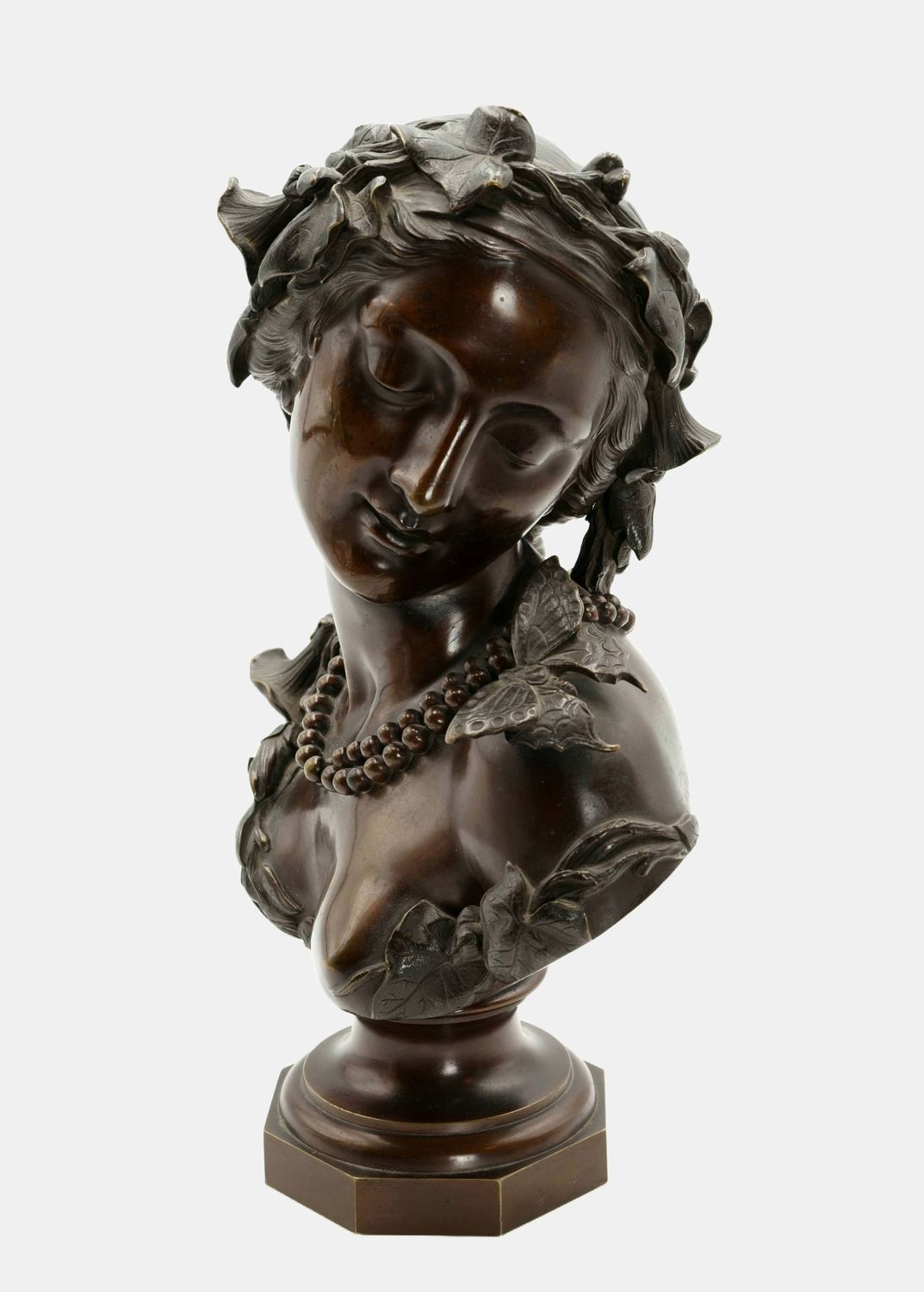Jaquet, Jan Jozef (1822-1898), Psyche, 1847
Jan Jozef Jaquet(1822 Antwerp - 1898 Brussels), Psyche , 1847. Black-brown and brown patinated bronze on a cast base. 30 cm (height) x 22 cm (width) x 12 cm (depth), weight 5 kg. Verso with J.[an] J.[ozef] JAQUET.” Inscribed, dated “1847” with the foundry mark “Cormann & Cie Bruxelles”.
- somewhat stained due to patina, very occasionally minimally rubbed, overall in excellent condition for its age
- Fulfilled longing -
Jan Jozef Jaquet masterfully expands the subject of the bust portrait. Classically, the bust is designed for a frontal view, which is predetermined by the horizontal shoulder line alone. The front view is also essential in Jaquet's bust, but a butterfly has settled on Psyche's shoulder and she is turning towards it, which also invites us to look at her from the side. If we follow this invitation, the butterfly unfolds to us in all its splendor, together with the beautiful face of the youthful Psyche. Her beauty had once aroused the envy of Venus and enchanted her son Armor, who finally succeeded in elevating Psyche to the heaven of the gods. Psyche gave birth to the beautiful daughter voluptas.
The mythical tale has a deeper meaning. In ancient Greek, 'psyche' means 'soul', so that the marriage of Armor and Psyche is also a marriage of the soul with the divine. In addition to 'soul', 'psyche' is also the term for 'butterfly', which is why, particularly in the later 18th century, the soul floating away after human death was depicted as a butterfly.
Psyche is watching the butterfly, which symbolizes herself, but at the same time she has her eyes devotedly closed and is filled with an inner soulfulness. At the same time, her face shows antique features: an elongated nose developing from the curve of the eyebrows, full lips and even eyes. Bringing the bust to life by depicting a specific situation is at the same time a revival of antique sculpture, which later earned Jaquet a professorship for sculpture after antiquity at the Brussels Academy of Fine Arts.
Corresponding to the sleep into which Venus had put Psyche, Psyche is adorned by a masterfully formed nightshade whose closed flowers begin to open, illustrating the blossoming of the soul in union with the divine.
In 1863, Jaquet was appointed professor at the Brussels Academy of Fine Arts, where Charles Samuel was one of his students. One of his most prestigious commissions was his artistic work for the Brussels Stock Exchange building designed by Léon-Pierre Suys, in whose sculptural decoration the young Auguste Rodin also collaborated. The two lions on the pedestals of the grand staircase are by Jaquet's hand.
About the artist
Jan Jozef Jaquet studied sculpture under Guillaume Geefs at the Antwerp Academy of Arts and followed his teacher to the Brussels Academy of Arts in 1839. There he first lived with the German landscape painter Peter Ludwig Kühnen, with whom he remained friends for the rest of his life. Kühnen also took in Jaquet's younger brother Jacques (1828-1899), who also studied sculpture and later worked closely with his brother.
From 1842 Jan Jozef Jaquet worked in the workshop of Guillaume Geefs, but from the same year he began to exhibit his works at the Brussels Salon, which established his artistic success. He was continuously represented at the Brussels Salon until 1875. In 1851, he received his first major commission to execute in marble the plaster model of The Golden Age that he had presented at the Salon. Subsequently, he became an extremely sought-after artist. In all, he created more than 300 sculptures and reliefs, including several monumental memorials such as the equestrian statue of Balduin I (1868) in Mons and the Monument to National Independence (1869) in The Hague. His oeuvre also includes around 30 busts, many of which were cast in bronze.

